Brasfield & Gorrie, one of the largest private construction companies, uses a 3D model obtained using drones to compare actual excavation work at a construction site with planned targets.
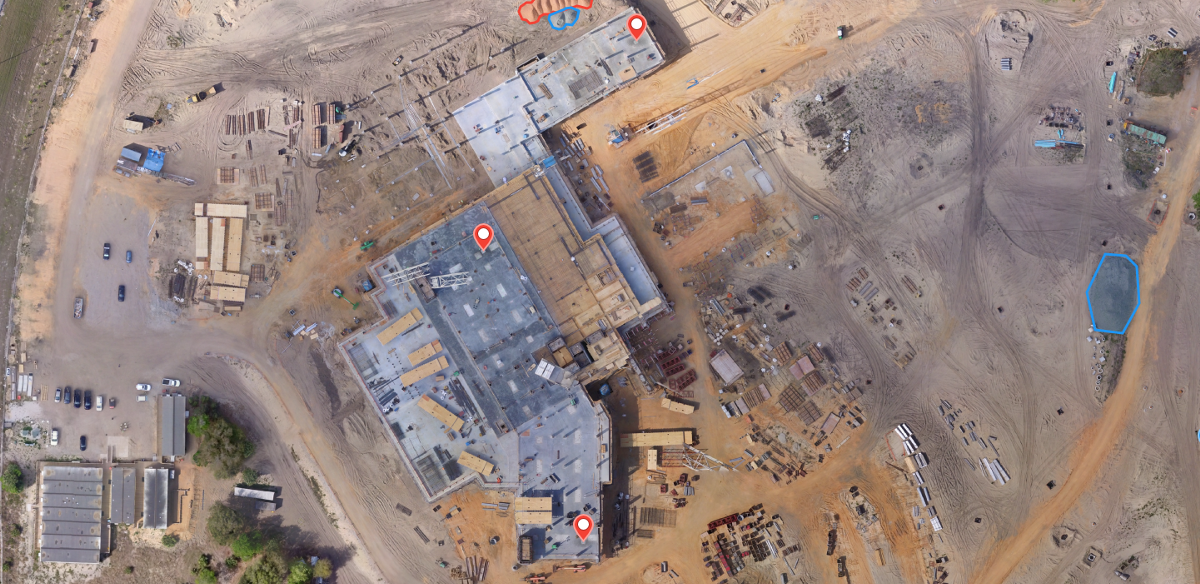
According
to this year
’s Goldman Sachs report , the construction sector will have the largest use of drones in the near future. We observed a similar trend when analyzing user data in the DroneDeploy system when preparing the report
“Use of drones in industry and commerce” - the use of drones grew most rapidly in the construction industry. Many were not surprised. Commercial and custom drone models today can easily fly around the construction area and quickly demonstrate the progress of construction on high-resolution maps and on three-dimensional models, which is a very effective solution compared to traditional methods.
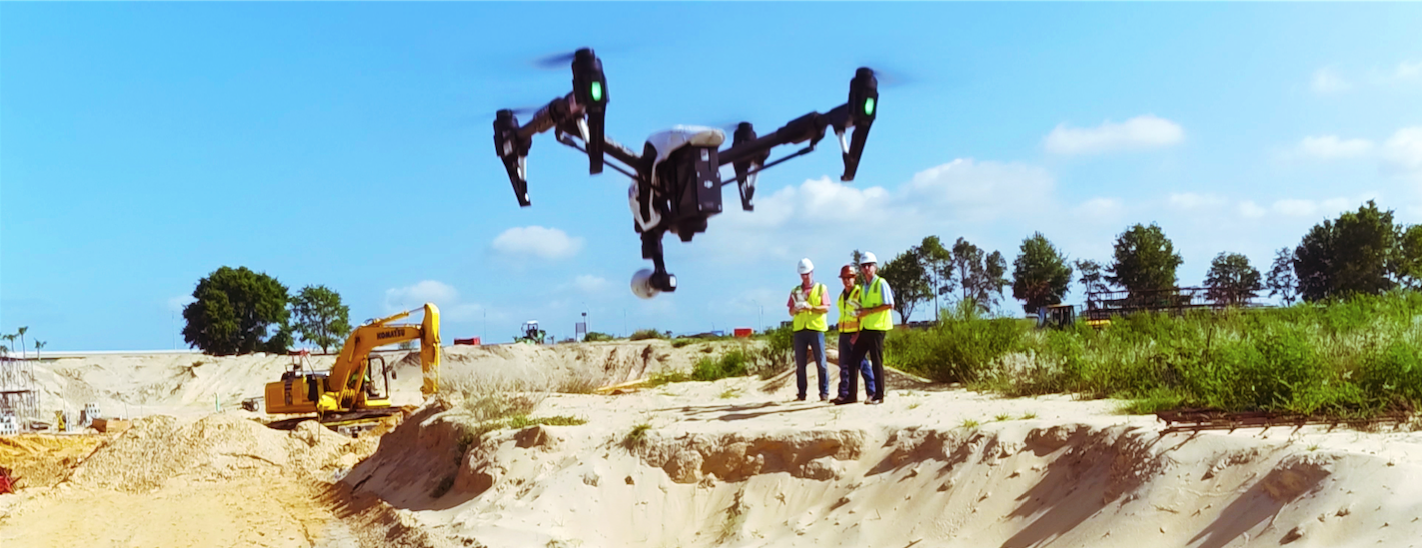
However, despite frequent discussions of the benefits of using drones in the construction industry, there are not too many real stories from construction companies that actually use drones.
Therefore, we are pleased to present to you the story from one of the largest private players in the US construction industry,
Brasfield & Gorrie, about the use of drones, in this case for obtaining a height map for the construction of the hospital and for comparing it with a construction plan to evaluate the performance of work.
Drones in Brasfield & Gorrie
Brasfield & Gorrie began using drones for observation a few years ago, but were forced to temporarily stop due to the need to obtain permission in accordance with the new regulations issued by the United States Federal Aviation Administration (FAA) on December 15, 2015. Today, the company is working with drones in the Virtual Design and Construction (VDC) group, in which 24 employees are engaged in the optimization of construction processes through the creation of a digital model of construction progress.
Hunter Cole, coordinator of visual design, describes the group’s activities in this way: “we participate in almost all the company's projects that require three-dimensional modeling”.
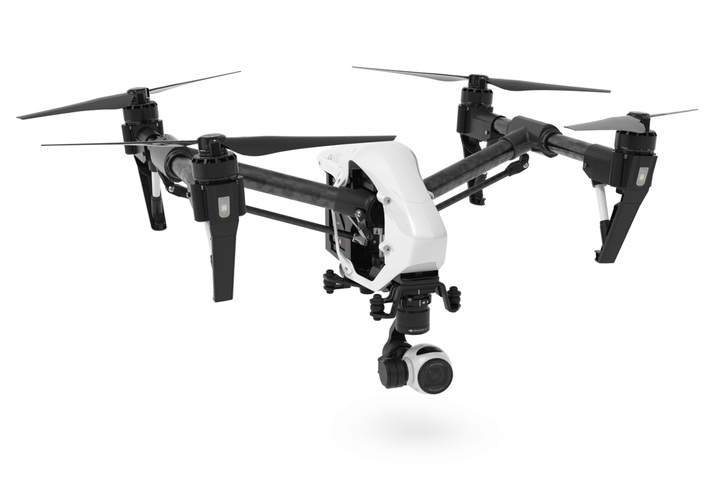
Each regional branch office is equipped with
DJI Inspire equipment. Whether it's aerial photography (photo or video), creating detailed 3D models using photogrammetry, drones allow you to quickly, safely and inexpensively collect information at all stages of construction.
Excavation work at the hospital construction site
During the construction of a hospital on a 61-acre site (24.4 hectares), the local branch of a construction company applied to the VDC group. The subcontractor announced the completion of preparatory earthworks, but the department manager was confident that the results of his work did not correspond to the planning documentation. Therefore, he requested the assistance of the VDC group to clarify the scope of work performed. The coordinator of the group Jesse Creech and field engineer Charles Curtis told us about the future.
“We were asked to find out the difference between the level of the construction site at the current time and the one that was planned,” said Charles Curtis.
Given the size of the construction site, drones were the best choice because measurement of vertical profile by traditional methods is a very long and costly process.
Flying around the area
The VDC group hired a local dronebase service provider to fly around the site using the assistance of a licensed pilot. Dronebase circled the site using the
Phantom 3 Pro model and the DroneDeploy mobile app to plan and automate the flight. Given the size of the site, it took to make several sorties. All the work took about an hour.
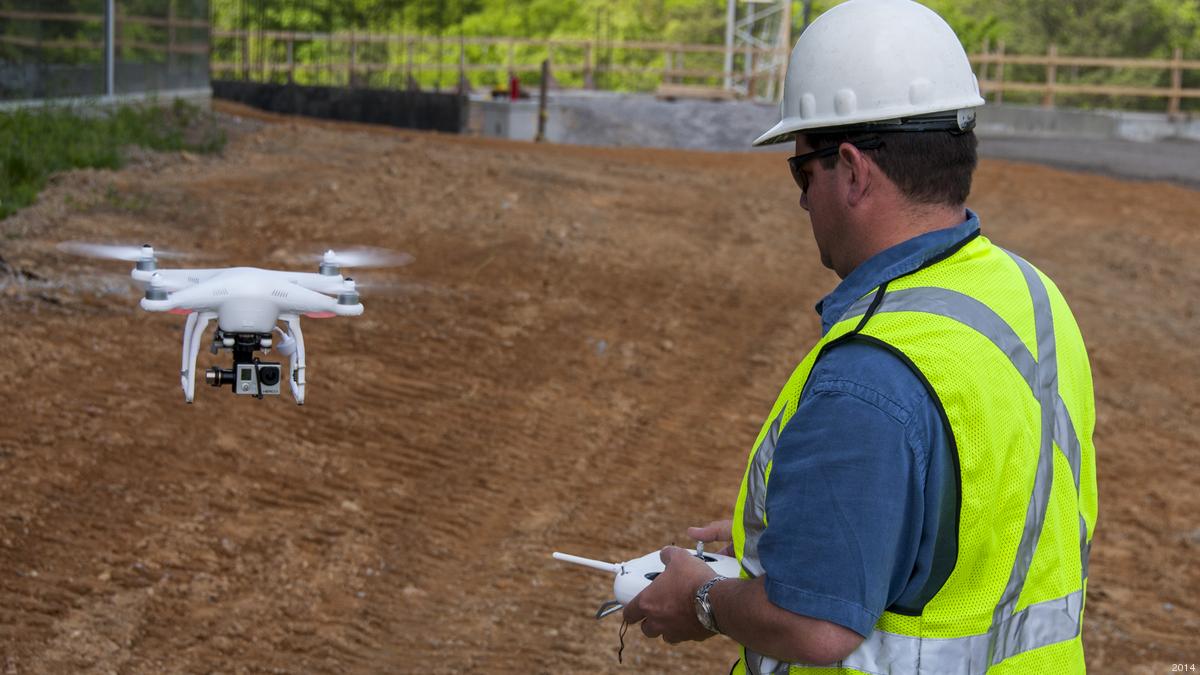
Since it was supposed to use the obtained map for a comparative analysis; it was important that when overlaying the existing drawings it exactly coincided with them. To ensure accuracy, Brasfield & Gorrie used ground control points (GCP, ground control points) (
learn more about GCP and map accuracy).
After flying around the construction site, Brasfield & Gorrie uploaded the obtained images to the cloud platform DroneDeploy, which on the same day based on them presented an orthomazic map, a vertical profile map and a 3D model.
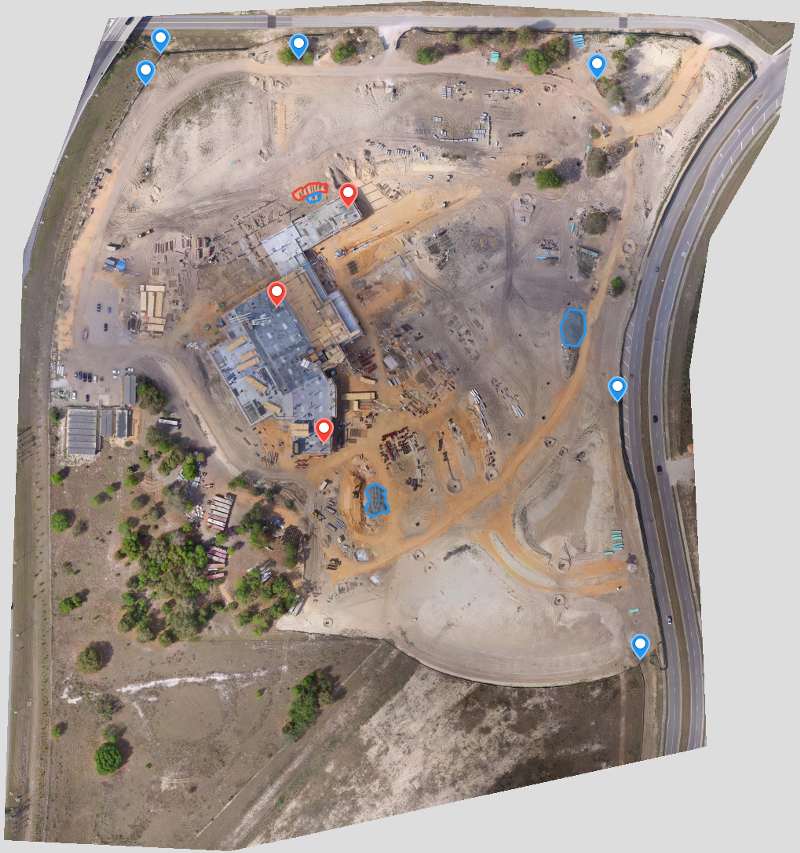
Ortho-mosaic map (
link to a large map with the possibility of approaching )
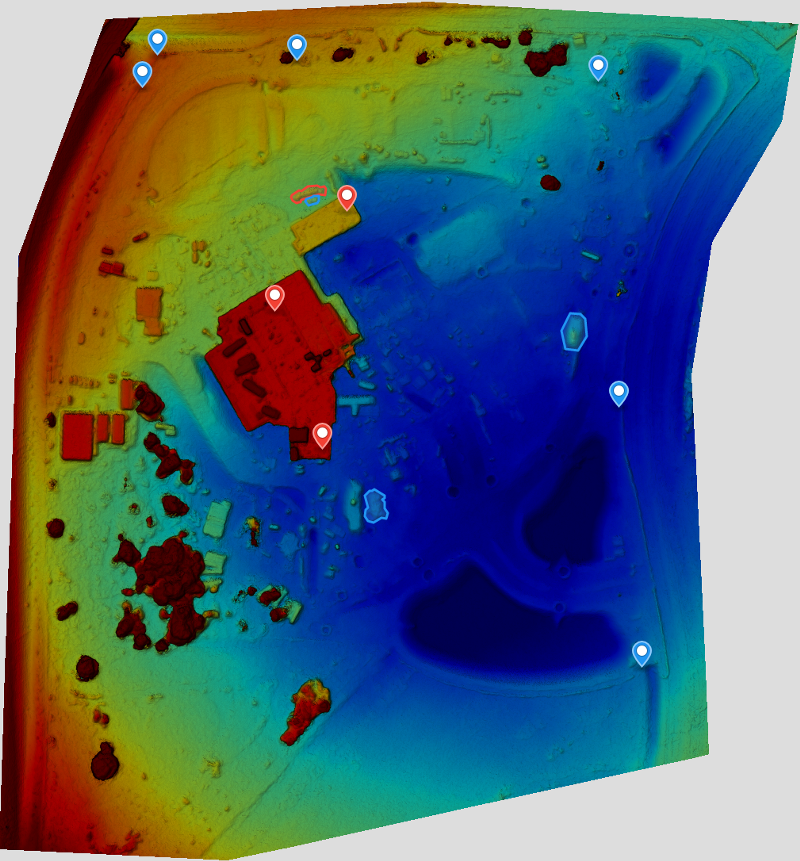 Click for a height map
Click for a height map .
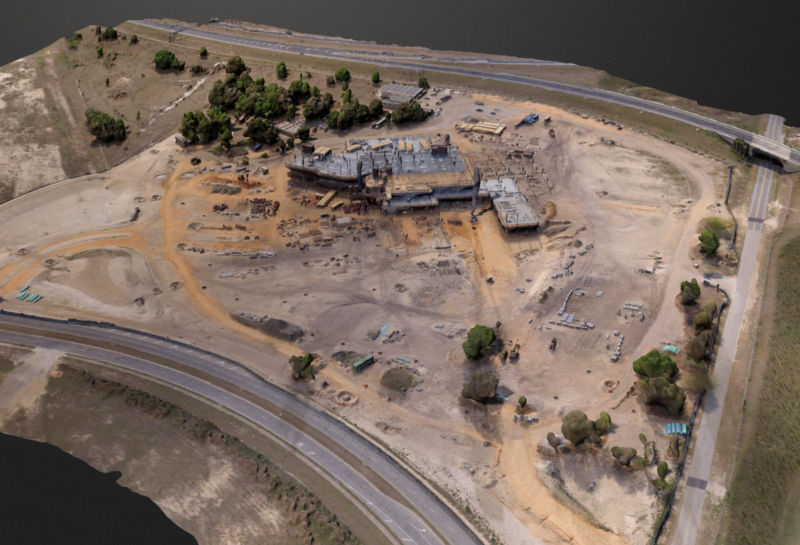 Click to view the 3D model
Click to view the 3D model .
Comparison of the plan and the actual state of the construction site
Having received the map from DroneDeploy, Jessie then had to translate it into the same format in which the planned drawings were made, striving for maximum accuracy (i.e. that the geographic labels coincide on both maps).
Entering data on ground control points, he made sure that the map was precisely aligned (this is possible using DroneDeploy's Premier plan). Next, Jesse exported the 3D model as a point set to third-party software. And from there I transferred the model to the required coordinate system, which was used to create the drawings (now it can be done with the help of DroneDeploy, just typing the 4-digit EPSG code, but at that time the VDC team did it through third-party software).
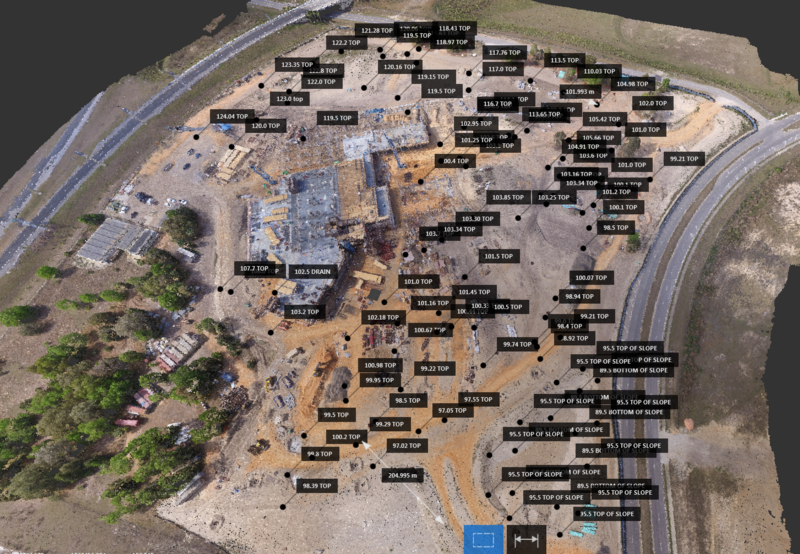 A visual projection of how a vertical profile correlates with a plan, using a three-dimensional point set
A visual projection of how a vertical profile correlates with a plan, using a three-dimensional point set .
When both models were properly aligned, Jesse was able to compare them. The result was a heat map showing the results of earthworks and their deviations from the plan: the zones marked in green coincide with the plan, blue - too low, pink - too high.
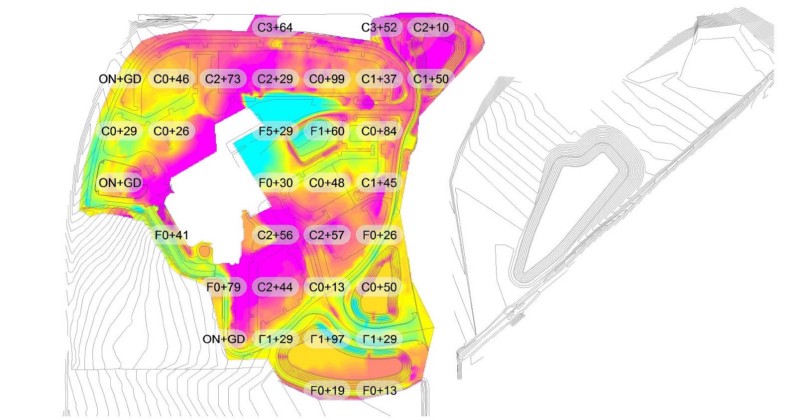
Vertical profile comparison heat map: the zones marked in green coincide with the plan, the blue one is too low, and the pink one is too high.
On the heat map of Jesse, you can clearly see what was done by the subcontractor.
According to the results of the comparison, it became clear that it is necessary to withdraw additional volumes of soil in order to achieve the required indicators for earthworks.
Faster data collection leads to higher returns.
Using drones, VDC was able to evaluate the results of earthworks much faster than if traditional methods were used without losing accuracy.
According to field engineer Charles, this kind of work would have required more than 1,000 verification shots.
“Usually we would use automated tacheometers to compile a grid of height points. I would have to use at least a 50 x 50 grid for a similar site. With an area of 61 acres, it would take more than 1,000 individual images with different settings. Combining this with regular work, we would have spent many weeks and would seriously get out of schedule. This 1000 shots will not allow us to learn about all the piles of waste land or ditches, so to maintain accuracy we would have to explore all the contours of unspecified parts, which will significantly increase the number of shots, ”says Charles.
And even if 1000 shots sound like a lot, the drone easily captures much, much more data, which allows you to create a much more accurate model of the vertical profile of the pad.
“Getting a lot of points, representing the entire site, in a couple of hours using a drone, is a huge advantage for the budget and the schedule,” said Jesse.
The speed of data analysis is in principle comparable to the speed when using other methods, but Charles is confident that the process will improve over time. “We learned a lot from this process, and I feel that in the future we will be able to increase the accuracy and significantly reduce the time for processing and analyzing data,” he said.
Overall, this example illustrated the tremendous time and resource savings that Brasfield & Gorrie can provide to topographic surveys made by drones. “The speed at which a drone can fly around and take detailed images saves a lot of time. According to my feelings, we spent three times less time on it than if we did it manually, ”- said Charles. Jesse summarized:
“Having spent a little time and money, we were able to find out the result of excavation work and draw conclusions, which in other cases can be very expensive and lengthy process. In this case, the ROI is very high. ”
Tips and best ways to use drones in the construction industry
Have you thought about introducing drones into your construction business? The VDC group of Brasfield & Gorrie can give you some tips:
- think over your task beforehand. There are no two identical construction sites, as well as the same difficulties with them. The worst thing you can do is to come to the site without a specific flight plan;
- set goals for yourself. Have an idea of what you will do with the information before you collect it, as this will allow you to select the level of detail needed to complete the task;
- Ensure compliance with the requirements of the Federal Aviation Administration (FAA). Be prepared to refuse the customer if order fulfillment involves a violation of safety or legislation;
- Enlist the help of these pilots. Brasfield & Gorrie attracted a licensed pilot to work in order to be able to use drones for commercial purposes;
- Explore the market carefully before buying drones - technology is moving fast.